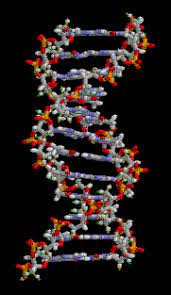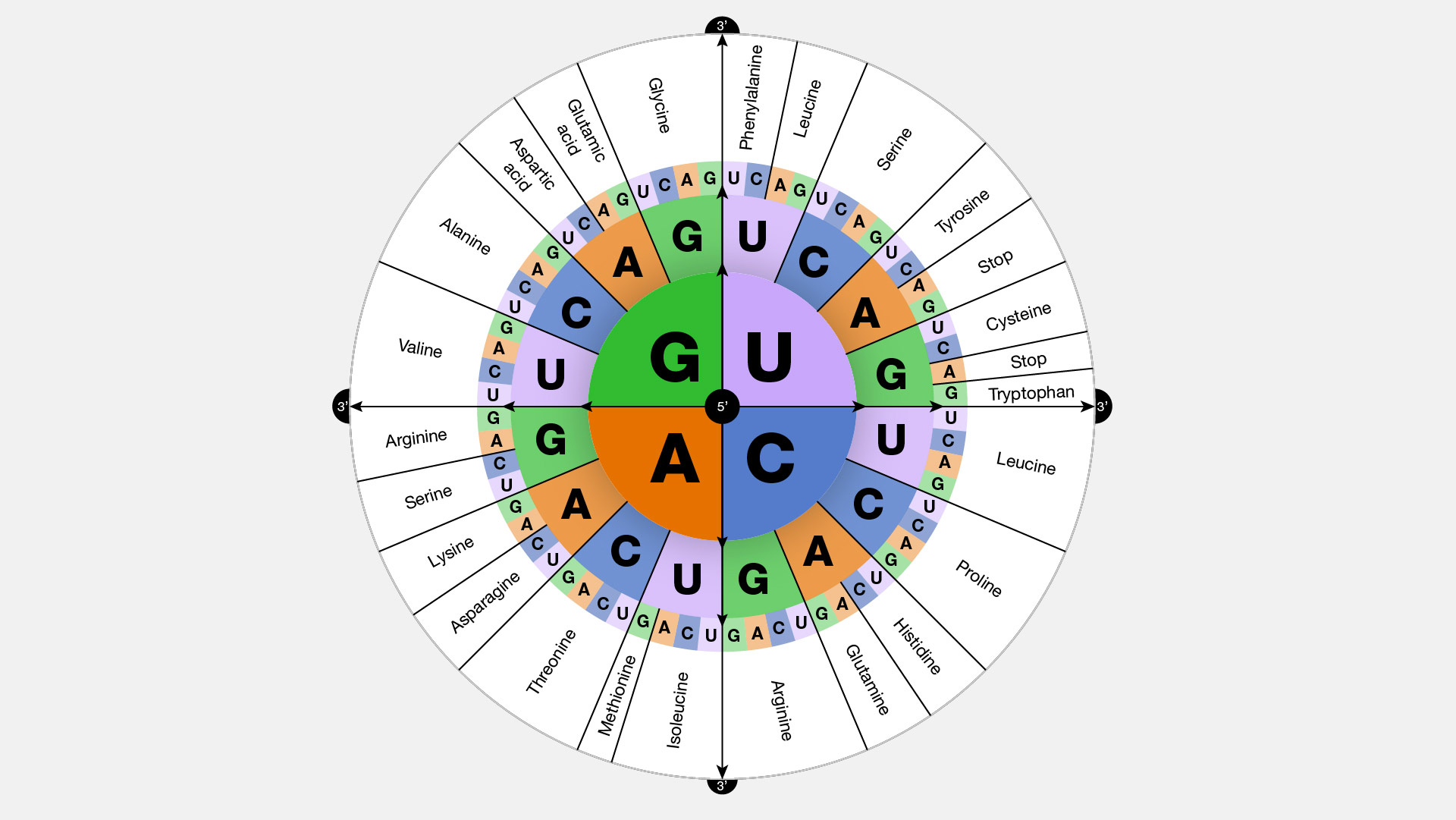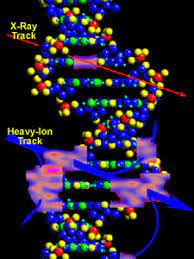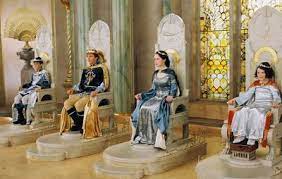| |
|
|

| |
|
|

Human cells (except for red blood cells) contain in their nuclei
pairs of chromosomes (number 1 through 22 plus X and Y sex-determining
chromosomes). Half of these 46 chromosomes are inherited from
one's father, and half from the mother. The female ovum always
contributes an X sex-determining chromosome, whereas the male
sperm contributes either an X or a Y sex chromosome determining
the sex of the child---whether it will be a boy (XY) or a girl
(XX), respectively. This amazing genetic code---arranged to form
the double-helix of DNA---governs not only the transmission of
thousands of characteristics of life from one generation to another,
but also oversees countless biological and chemical interactions
of living cells on a moment by moment basis.
There are on average 30,000 genes per chromosome. The longest
chromosomes contain 300 million bases. The genetic alphabet out
of which genes are composed consists of four "letters,"
or bases. Each of these nucleic acid bases must be joined to its
neighbors in precisely the correct order! Prof. A. E. Wilder Smith
notes that the arrangement of bases is three-dimensional---an
equivalent amount of information packed into two dimensions would
make the length of the genome many thousands of miles long! Individual
genes govern skin color, eye color, a multitude of other physical
characteristics, and a good many less tangible factors such as
intelligence level and temperament as well.
The complete total of chromosomes which constitutes the human
"genome" consists of at least 3.5 billion bases. In
1986 The National Academy of Sciences began the ambitious process
of decoding the human genome---expected to take about 2 years
and three billion dollars. Time magazine for the week of
February 8, 1993, however reported an accelerated program ytam of scientists in France who expect to get the job done two
years before the Americans. [A Nova Science television
program on the human genome program had the fascinating title,
The Book of Life, perhaps suggesting the record books that
God keeps as described in Bible passages such as Revelation 20:11-14].
The genetic codes in all living things represents an enormous
degree of complexity. Chromosomes are made up of NUCLEIC ACIDS
(not amino acids). Nucleotides are made up of three components:
a heterocyclic nitrogenous base (adenine, thymine, cytosine, or
guanine) a pentose (a sugar), and a phosphoryl group. The bases
themselves do not link together to form the double helix -- the pentose-phosphate portion of the molecules
form phosphodiester bonds (not peptide bonds) to form the backbone
of the double helix.Nucleotides (unlike amino acids) do not have
right and left-handed configurations, per se. But the double helix
can form in either a right or left-handed direction. Most DNA
is in the right-handed double helix form, although there are certain
unusual situations in which the left-handed double helix is used.
Nucleotides are joined by phosphodiester bonds (not peptide bonds).
Peptide bonds occur only between amino acids, primarily in the
formation of proteins. DNA is not a protein. It is true that multiple
special enzymes are required. I find this part of DNA formation
fascinating. Some enzymes actually have a proof-reading function,
double checking to make sure that not mistakes in<
transription are made. As far as I know, most mistakes (mutations)
are random in the sense that an unusual nucleic acid ends up in
the wrong place and is not caught by the proof-reading enzymes.
This only happens about once every several million base pairs,
and is usually taken care of enzymes which recheck DNA post-replication."
(1)
According to Genesis, God created various kinds (Heb: min)
of living things from simple grasses to man. Each kind contains
its own unique genetic program code (seed) allowing the
parent organism(s) to replicate either sexually or asexually.
Evidently these genetic codes were written by our Creator with
a redundant amount of information in them---providing all the
information needed for a wide variety in the offspring and also
permitting a considerable amount of modification and adaptation
within each kind. The term kind used in Genesis is not
necessarily synonymous with the secular scientific term species,
however it is clear that one kind of life does not interbreed
with another kind. Mutations (caused by cosmic rays for
instance) cause damage to genes in the chromosome, but these are
always disadvantageous to the individual and represent errors
in the genetic codes.
Tremendous variation is possible within kinds. To give just one
simple example, the table below shows all the possible combinations
of the skin-color pigment melanin starting with two medium-skinned
parents, AaBb. Only 6 out of 16 possible combinations leading
to medium skin color will occur. The combination AABB produces
only dark skin, aaBB produces only medium skin and aabb only light
skin. Four each of their children can be expected to have either
dark or light skin. All these possible combinations could occur
in only one generation! It follows that Adam and Eve were created
with the complete gene pool now found in all human beings who
have ever lived or who are alive today, or yet to be born!
A narrowing of the genetic funnel would have occurred at the time
of the Flood a few thousand years ago. The Biblical view is that
all current members of the human race on earth are descendants
of Noah and his wife. There is therefore but one "race"
of men on earth. An immediate genetic diversification then set
in, in the rapid re-population of the earth through Noah's three
sons, Shem, Ham, and Japheth. (See Genesis 10, 11).

| - | AB | Ab | aB | ab | |
|---|---|---|---|---|---|
| AB | AA | AA | Aa | Aa | |
|
|
BB | Bb | BB | Bb | |
| Ab | AA | AA | Aa | Aa | |
|
|
Bb | bb | Bb | bb | |
| aB | Aa | Aa | aa | aa | |
|
|
BB | Bb | BB | Bb | |
| ab | Aa | Aa | aa | aa | |
|
|
Bb | bb | Bb | bb |

![]()
 Did you know that for every generatiosn that passes, more and more mistakes are piling up in the human genome? This means your DNA has more mistakes than your parent’s DNA, which has more mistakes than their parents’ DNA, which has more mistakes than their parents, which has—well, you get the point!
These mistakes are caused by mutations, which are basically coping errors when DNA is replicated. Now, thankfully for us, most of these mutations have no noticeable effect. But, even if we do not notice them, they are still there, corrupting our DNA.
Did you know that for every generatiosn that passes, more and more mistakes are piling up in the human genome? This means your DNA has more mistakes than your parent’s DNA, which has more mistakes than their parents’ DNA, which has more mistakes than their parents, which has—well, you get the point!
These mistakes are caused by mutations, which are basically coping errors when DNA is replicated. Now, thankfully for us, most of these mutations have no noticeable effect. But, even if we do not notice them, they are still there, corrupting our DNA.
A conservative estimate says that 100-300 new mutations occur in human reproductive cells per individual per generation. Some numbers are as high as 1000 new mutations per individual per generation. That is a lot of mistakes! Now, most people think that natural selection will get rid of these mutations. After all, isn’t that its job? Well, it is not quite that easy. You see, natural selection can only select against mutations that have a noticeable and significant effect – in the moment! If the mutation is neutral or even if it’s harmful, but hasn’t caused death or serious harm, natural selection won’t get rid of it because it can’t see it. This leads to what is known as “genetic entropy.”
This means that each generation carries all the mutations of previous generations, plus its own new mutations. And with the high mutation rate, genetic entropy is increasing quickly. In fact, it is increasing so fast there is no way humans have been on the planet for millions of years, like evolution suggests. Our genetic code would be so burdened with mutations, we would be such a mess that we would be extinct!
Our genetic code does not look like it has been mutating for even tens of thousands of years. Instead, it looks like it was incredibly well designed and has only been subject to the degrading influence of mutations for a short time. What does this imply? It certainly fits with the Biblical historical accounts, that God created mankind about 6,000 years ago, with a perfect genome. It was not until after sin entered the world that mutations began to corrupt our DNA, and there has not been enough time since then to completely destroy our genome. (The “Code” of Life and Genetic Entropy – by David Rives. April 19, 2021, May 4, 2021)
 An excellent introduction to the central question of biological
origins is the book Of Pandas and People, by Percival Davis
and Dean H. Kenyon, Haughton Publishing Co., Dallas, TX 1989.
An easy to understand book presenting evidence for creation and
refutation of the many of the arguments of the myth of evolution
is Creation: Facts of Life by Gary Parker, Master Books,
PO Box 26060 Colorado Springs, CO 80936, 1994.
An excellent introduction to the central question of biological
origins is the book Of Pandas and People, by Percival Davis
and Dean H. Kenyon, Haughton Publishing Co., Dallas, TX 1989.
An easy to understand book presenting evidence for creation and
refutation of the many of the arguments of the myth of evolution
is Creation: Facts of Life by Gary Parker, Master Books,
PO Box 26060 Colorado Springs, CO 80936, 1994.
In The Mystery of Life's Origin: Reassessing Current Theories,
Charles Thaxton, Walter Bradley and Roger Olsen (Philosophical
Library, NY 1984) calculate the energy and entropy levels involved
in assembling the complex molecules that comprise the genetic
code. From their work it is clear that the complex genetic program
each of us inherited was created by a Superior Intelligence at
the beginning-it could not possibly have "evolved."
The Second Law of Thermodynamics demands that orderly, complex
systems break down, fall apart, rot, rust and decay with the passage
of time. Outside energy and outside Intelligence were required
to bring the genetic code into existence.
The God of the Bible brings:
matter out of nothing,
order out of chaos,
light out of darkness,
and life out of death.

By Jennifer Viegas Special to ABCNEWS.com
April 21 - It may be the world's largest known family
tree.
Researchers from Oxford University in Oxford, England, have
identified seven ancestral matriarchal groups from which all Europeans
appear to be descended. These maternal clans form the root of
a family tree that has sprouted millions of individuals.
Every European, according to the study, can trace his or her evolutionary
history back to the seven ancestral mother groups, also referred
to as the Seven Daughters of Eve.
The researchers, who both discovered and formulated the genetic
groupings, say these women would have lived between 8,000 to 45,000
years ago.
Hamsters Inspired Theory
Bryan Sykes, professor of human genetics at Oxford University,
first suspected Europeans could have common lineages when he was
a young boy. His inspiration came from a news story he read that
stated all hamsters in the world came from one pregnant female
found in the Syrian desert in 1930.
Time passed, but he remembered the hamsters. In recent years,
he tested out the hamster idea by identifying and ordering the
individual components of DNA taken from the droppings of several
of these rodents.
He discovered that one specific kind of genetic material, mitochondrial
DNA, appeared to be identical among all of the hamsters. This
kind of DNA can only be passed down from a mother to her children.
Men have mtDNA in their sperm, but a chemical marks it for destruction
during the fertilization process. Therefore, the hamster study
findings prompted Sykes to add matriarchal clans to his developing
theory about common lineages.
A Cheeky Business
Then, Sykes applied similar research methods to a study
on humans. He and his colleagues took cell samples from the cheeks
of 6,000 Europeans and analyzed their mitrochondrial DNA.
Unlike hamsters, which share one type of mtDNA, the human test
subjects' DNA clearly fit into seven distinct groups: the seven
daughters on the European family tree. The "daughters"
notion is more figurative than literal, as it broadly refers to
seven matriarchal genetic groups, rather than to seven individual
women.
Leonardo Salviati, a post doctoral researcher at Columbia University
who specializes in mitochondrial DNA studies, says Sykes' theory
"is plausible."
"Mitochondrial DNA allows us to trace human evolution,"
says Salviati. "DNA mutates at a very slow rate, so if you
can accumulate mutations and categorize them in specific groups,
you can draw direct ancestral lineages."
Mutations in this kind of DNA occur in humans about every 10,000
years. Sykes, therefore, is able to guess when each of the seven
female genetic lines first appeared in Europe.
The earliest suspected arrival date, 45,000 years ago, corresponds
with the appearance of modern human remains in fossil records.
But this date is thousands of years ahead of when anthropologists
previously thought migrants arrived in Europe.
Links to African Eve
Further, all seven of the genetic groups appear to be
descended from the "Lara" clan, one of three clans that
still exist today in Africa. This supports the African Eve theory,
proposed in the late '80s by biochemist Allan Wilson, Mark Stoneking
and others, which states that all humans share a common African
ancestor. Wilson and his colleagues used the same genetic material,
mtDNA, for their study.
Terry Melton, president of Mitotyping Technologies, a firm specializing
in mtDNA forensic studies, says, "[Sykes] presents a great
idea, but the system is not perfect. A consensus may be derived
by formulating haplogroups [gene groups], but it would be impossible
to do this with 100 percent accuracy."
Melton explains that some parts of the mtDNA mutate faster than
others, so additional variation could appear within the seven
daughter groups.
What About Americans?
Americans of European heritage may fit into one of the
seven categories. But different genetic groups based upon mtDNA
variations likely exist for those without European ancestors.
Native Americans, for example, appear to have descended from Asians
who migrated to the Americas sometime between 30,000 and 3000
BC. Melton says they seem to have limited mtDNA variations, meaning
that they probably descended from just a few Asian lineages.
In future, Sykes hopes to map out genetic groups for other continents,
to perhaps find out more about the mothers to us all.
The Seven Daughters of Eve
Professor Sykes and his team have created profiles for
each of the seven matriarchal groups. They are:
Helena - This clan lived in the ice-capped Pyrenees. As the climate
warmed, Helena's descendants trekked northward to what is now
England, some 12,000 years ago. Members of this group are now
present in all European countries.
Jasmine - Her people had a relatively happy life in Syria, where
they farmed wheat and raised domestic animals. Jasmine's descendants
traveled throughout Europe, spreading their agricultural innovations
with them.
Katrine - Members of this group lived in Venice 10,000 years ago.
Today most of Katrine's clan lives in the Alps.
Tara - Sykes' maternal ancestry goes back to this group, which
settled in Tuscany 17,000 years ago. Descendants ventured across
northern Europe and eventually crossed the English Channel.
Ursula - Users of stone tools, Ursula's clan members drifted across
all of Europe.
Valda - Originally from Spain, Valda and her immediate descendants
lived 17,000 years ago. Later relatives moved into northern Finland
and Norway.
Xenia - Not much is known about Xenia, but it is believed that
her people lived in the Caucasus Mountains 25,000 years ago. Just
before the Ice Age, this clan spread across Europe, and even reached
the Americas.
Oxford Ancestors, a venture associated with Oxford University,
will trace individual matrilineal DNA, for a fee of $180 per test
(see link).
With a new technique based on the male, or Y, chromosome, biologists have traced the diaspora of Jewish populations from the dispersals that began in 586 BC to the modern communities of Europe and the Middle East.
The analysis provides genetic witness that these communities have, to a remarkable extent, retained their biological identity separate from their host populations, evidence of relatively little intermarriage or conversion into Judaism through the centuries.
Another finding, paradoxical but unsurprising, is that by the yardstick of the Y chromosome, the world's Jewish communities closely resemble not only one another but also Palestinians, Syrians and Lebanese, suggesting that all are descended from a common ancestral population that inhabited the Middle East about 4,000 years ago.
Lawrence H. Schiffman, chairman of the department of Hebrew and Judaic Studies at New York University, said the study fit with historical evidence that Jews originated in the Near East and with biblical evidence suggesting that there were a variety of families and types in the original population. He said the finding would cause ``a lot of discussion of the relationship of scientific evidence to the manner in which we evaluate long-held academic and personal religious positions,'' like the question of who is a Jew.
The study, reported in today's Proceedings of the National Academy of Sciences, was conducted by Dr. Michael Hammer of the University of Arizona with colleagues in the United States, Italy, Israel, England and South Africa. The results accord with Jewish history and tradition and contradict theories such as those holding that Jewish communities consist mostly of converts from other faiths or that they are descended from the Khazars, a medieval Turkish tribe that adopted Judaism.
The analysis by Hammer and his colleagues is based on the Y chromosome, which is passed unchanged from father to son. Early in human evolution, all but one of the Y chromosomes were lost as their owners had no children or only daughters, so that all Y chromosomes today are descended from that of a single genetic Adam who is estimated to have lived about 140,000 years ago.
In principle, all men should therefore carry the identical sequence of DNA letters on their Y chromosomes, but in fact occasional misspellings have occurred, and because each misspelling is then repeated in subsequent generations, the branching lineages of errors form a family tree rooted in the original Adam.
These variant spellings are in DNA that is not involved in the genes and therefore has no effect on the body. But the type and abundance of the lineages in each population serve as genetic signature by which to compare different populations.
Based on these variations, Hammer identified 19 variations in the Y chromosome family tree. The ancestral Middle East population from which both Arabs and Jews are descended was a mixture of men from eight of these lineages.
Among major contributors to the ancestral Arab-Jewish population were men who carried what Hammer calls the ``Med'' lineage. This Y chromosome is found throughout the Mediterranean and in Europe and may have been spread by the Neolithic inventors of agriculture or perhaps by the voyages of sea-going people such as the Phoenicians.
Another lineage common in the ancestral Arab-Jewish gene pool is found among today's Ethiopians and may have reached the Middle East by men who traveled down the Nile. But present-day Ethiopian Jews lack some of the other lineages found in Jewish communities, and overall are more like non-Jewish Ethiopians than other Jewish populations, at least in terms of their Y chromosome lineage pattern.
The ancestral pattern of lineages is recognizable in today's Arab and Jewish populations, but is distinct from that of European populations and both groups differ widely from sub-Saharan Africans.
Each Arab and Jewish community has its own flavor of the ancestral pattern, reflecting their different genetic histories. Roman Jews have a pattern quite similar to that of Ashkenazis, the Jewish community of Eastern Europe. Hammer said the finding accorded with the hypothesis that Roman Jews were the ancestors of the Ashkenazis.
Despite the Ashkenazi Jews' long residence in Europe, their Y signature has remained distinct from that of non-Jewish Europeans.
On the assumption that there have been 80 generations since the founding of the Ashkenazi population, Hammer and his colleagues calculate that the rate of genetic admixture with Europeans has been less than a half-percent per generation.
Jewish law tracing back almost 2,000 years states that Jewish affiliation is determined by maternal ancestry, so the Y chromosome study addresses the question of how much non-Jewish men may have contributed to Jewish genetic diversity. Hammer was surprised to find how little that contribution was. ``It could be that wherever Jews were, they were very much isolated,'' he said.

According to detailed biblical chronologies and genealogies, the global Flood recorded in Genesis that wiped out humanity occurred about 4,500 years ago. 1,2 Then the earth was repopulated by Noah’s three sons and their three wives. As I reported a couple months ago, a research project was just published that used high quality DNA sequence data to develop a human Y-chromosome genetic clock that matches up perfectly with the Bible’s timeline of modern human origins. 3,4
Now, the same researcher has shown that human population growth curves over the past few thousand years match up with both the new Y-chromosome data and biblical event chronology. 5
The majority of evolutionary speculation alleges that modern humans didn’t arise until our ancestors migrated out of Africa between 100,000 and 200,000 years ago. However, a number of secular and creationist research studies analyzing a variety of DNA clocks have indicated a far shorter time-scale of not more than 5,000 to 10,000 years. 6-9And a new more precise human Y-chromosome DNA study demonstrates that not only are the previous studies vindicated in their short time predictions, the Bible’s timeline of the global Flood appears to be spot on. In fact, the researcher in the study empirically showed that only about 4,500 years of mutations have accumulated in the DNA record of the human Y chromosome. If mankind has been around for 100,000 to 200,000 years, we should’ve accumulated between 8-59 times the number of mutations actually observed. 4
But what about human population growth? Does it match up with these Bible-based timelines and the new genetic data? As it turns out, secular scientists and creationists generally agree on the basic events and population growth models for the past 3,000 years. But when dates get beyond this, there are discrepancies in their models.
Creationist researcher, Nathanial Jeanson, determined to see how population growth would match up with splits in lineages in Y-chromosome genetic clock data. 5 This was possible because this type of genetic data can be analyzed in a tree-like structure. Along this line of reasoning, a biblical timescale predicts that the last 4,500 years of human population growth should be reflected in the branching events of human lineages in the Y chromosome tree data—not just in the lineages represented in the “tips” of the tree. And quite interestingly, the population growth and Y-chromosome data also appear to fit well with specific shifts in population structure in ancient history such as the global famine described during the Bible patriarch Joseph’s life as a ruler in Egypt, as described in the in the later chapters of Genesis. A global famine would dramatically stunt population growth and be detected in genetic branch analyses.
In regards to the importance of these new results, Jeanson told ICR staff,
Indeed, this new study, isn’t only a sound refutation of evolutionary speculation, but a strong confirmation for mankind’s recent origins.
References
1. Johnson, J. J. 2008. How Young Is the Earth? Applying Simple Math to Data in Genesis. Acts & Facts. 37 (10): 4-5.
2. Hardy, C. and R. Carter. 2014. The biblical minimum and maximum age of the earth. Journal of Creation. 28 (2): 89-96.
3. Tomkins, J. P. 2019. Y-Chromosome Study Confirms Genesis Flood Timeline. Creation Science Update. Posted on icr.org December 17, 2019, accessed January 24, 2020.
4. Jeanson, N. T. and A. D. Holland. 2019. Evidence for a Human Y Chromosome Molecular Clock: Pedigree-Based Mutation Rates Suggest a 4,500-Year History for Human Paternal Inheritance. Answers Research Journal. 12: 393-404.
5. Jeanson, N. T. 2019. Testing the Predictions of the Young-Earth Y Chromosome Molecular Clock: Population Growth Curves Confirm the Recent Origin of Human Y Chromosome Differences. Answers Research Journal. 12: 405–423.
6. Tomkins, J. P. 2015. Genetic Clocks Verify Recent Creation. Acts & Facts. 44 (12): 9-11.
7. Jeanson, N. T. 2015. A Young-Earth Creation Human Mitochondrial DNA “Clock”: Whole Mitochondrial Genome Mutation Rate Confirms D-Loop Results. Answers Research Journal. 8: 375–378.
8. Jeanson, N. T. 2016. On the Origin of Human Mitochondrial DNA Differences, New Generation Time Data Both Suggest a Unified Young-Earth Creation Model and Challenge the Evolutionary Out-of-Africa Model. Answers Research Journal. 9: 123–130.
9. Tomkins, J. P. 2019. Six Biological Evidences for a Young Earth. Acts & Facts. 48 (5):10-13.
Dr. Tomkins is Life Sciences Director at the Institute for Creation Research and earned his doctorate in genetics from Clemson University.
See also
World Population Before the Flood
Creation and Catastrophe Chronology
The Great Flood of Noah
Population of the Preflood World
Index to Papers on Creation
Articles on Time
Non-Constancy of the Speed of Light
A Psalm of David
O LORD, thou hast searched me and known me!
Thou knowest when I sit down and when I rise up;
thou discernest my thoughts from afar.
Thou searchest out my path and my lying down,
and art acquainted with all my way


![]()
Lambert's Original Main Library
Email Lambert Dolphin
Archive for Newsletters
Library Annex (900+ new articles since 2018. Free. )

